Statistical Analysis of the Wave Runup at Walls in a Changing Climate by Means of Image Clustering
Abstract
:1. Introduction
2. Tests and Laboratory Setup
- Different wave-breaking conditions, obtained by selecting both cot(αd) = 4 and 2; the two slopes, which will be referred as “c4” and “c2” hereinafter, were set up in the lab to determine, respectively, spilling breaker types, with values of the Iribarren–Battjes’ breaker parameter ξm−1,0 in the range 1.41–1.72 and plunging breakers, with ξm−1,0 = 3.03–3.72. For each test, ξm−1,0 was calculated at the toe of the structure based on the values of Hs and Lm−1,0 measured in the wave channel;
- The wall heights, by reducing hw from 0.05 to 0.04 m;
- The berm relative submergence, by introducing the condition of emerged berm with hb/Hs = −0.5;
- The parapet.
3. The Video Cluster Methodology
3.1. Description of the Methodology
- the extension of the existing procedure to the area including the crown walls placed at the inshore edge of the berm and beyond; such extension involves: (i) the adaptation of the pre-clustering techniques to deal with the presence of the wall, (ii) the adaptation of the procedure for the detection of the free surface to the area including the walls and (iii) the elimination of the 3D effects affecting the pictures in the area around the walls;
- a package of new procedures is developed to further manipulate the free-surface elevation in order to extract the following new quantitative data: (i) the wave runup height at the walls, (ii) the number of overtopping waves behind the crown wall and (iii) the number of the wave impacts at the walls.
3.2. Setup of the Virtual Gauges
3.3. Accuracy of the Methodology
4. Calculation of the Wave Runup
4.1. Adaptation of the Pre-Filtering Techniques
4.2. Extension of the Free-Surface Tracking to the Wall Area
4.3. Perspective Distortion Correction
5. Statistical and Parametric Analysis of the Wave Runup
5.1. Probability of Exceedance of the Wave Runup
- for the same wave attack, increased rates of Ru of c. 11–12% should be expected when a parapet is included on top of wall;
- in an intermediate condition of sea-level rise projection of c. 0.5 m by the end of the 21st century, Rumax might increase by up to +20% with respect to present conditions;
- runup heights and overtopping rates (beyond the walls), being differently affected by the structural geometrical parameters, are not necessarily correlated, i.e., the two quantities do not necessarily increase contemporarily.
5.2. Comparison of the Wave Runup Heights with the Literature
5.3. Wave Runup Envelopes: Design Conditions
- The different configurations associated to the slope c2 (Figure 14) show a higher variability of the Ru-envelopes, ranging between 0.110 and 0.175 m, than the tests c4, which range from between 0.125 and 0.175 m. The effect of the different geometries is indeed more evident in this group of tests with respect to the group c4 (Figure 13); the profile obtained for the test TW6 (lower wall height, hw = 0.04 m) is well below the profile for the test TW5 (benchmark case for c2) and the profile of TW7 (emerged berm, hb/Hs = −0.5) is in turn systematically below TW6. Overall, the envelope of TW8 (parapet) is above all the other envelopes, showing Ru-values ranging between 0.140 and 0.175 m;
- Contrary to this and in the case of c4 (Figure 13), the sensitivity to the geometrical parameters is modest and the profiles intersect each other across the whole wall cross section. The envelope of the test with the parapet (TW4) is locally—but not systematically—above all the other envelopes. It is interesting to note that the envelopes associated with TW1 (benchmark case for c4) and to TW4 (emerged berm) show similar variability ranges of Ru (0.133–0.175) and similar spikes;
- A strong variability of Ru across the x- and y-direction is observed. This variability is randomly distributed and the spikes, varying from test to test, are not concentrated either at the front sides of the wall, nor around its middle section. Therefore, it can be concluded that the side walls—which are made of glass—do not generate side effects due to potential friction or capillarity phenomena, and the presence of the pressure transducers located in the middle of the front-section of the walls, do not disturb the runup flow. In conclusion, the variability of the wave runup in the y-direction cannot be explained by side effects from the wave flume side walls.
5.4. Wave Runup Envelopes: Exercise Conditions
- in average conditions, both the configurations (slopes c4 and c2) are always overtopped;
- in the case of TW4 (spilling breaker type), the average overtopping rate is expected to be modest, since the envelope is very close to the wall top, while in case of TW8 (plunging breaker) the “standard” overtopping represents a severe condition;
- for this latter test, overtopping randomly occurs across the wall front section even in the case of minimum runup: this outcome suggests that the structural configuration corresponding to TW8 is clearly inadequate to face the wave attack conditions in the case of sea-level rise determining hb = 0.
6. Conclusions
- Under an intermediate scenario of sea-level rise of ≈0.5 m up to the end of the 21st century, by assuming the same wave attack conditions, an average increase of ≈20% of Rumax at the walls could be expected;
- Furthermore, the inclusion of a recurving parapet on top of crown walls as a measure to reduce the wave overtopping discharge might generate an average increase of Rumax of ≈11–12%, implying higher spray jets, more severe wave loads at the walls and higher wave reflection from the berms.
- Well fix the camera and ensure that the framing window is the same for the whole campaign of tests (or at least, for each set of tests);
- Re-calibrate the camera daily and for each set of tests;
- For laboratory tests, if possible, install the camera inside a black box to reduce light reflection and any possible disturbance.
Author Contributions
Funding
Data Availability Statement
Conflicts of Interest
List of Notations
| B | Berm width |
| h | Free-surface elevation calculated along the profile of the structure and calculated as vertical distance between the free-surface itself and the solid contour of the structure |
| hb | Berm submergence (hb < 0 and hb > 0 respectively for emerged and submerged berm) |
| hc | Elevation of the structure berm with respect to the bottom of the channel, excluding the crown wall |
| hn | Height of the parapet (when present) on top of the crown wall |
| hw | Height of the crown wall |
| Hs | Significant wave height |
| Hmax | Maximum wave height |
| Lm−1,0 | Wavelength from spectral analysis |
| MRPE | Mean Reprojection Error per image |
| N | Number of points in an image |
| P | Probability of exceedance of the runup height |
| Pi | Reference to the i-th (virtual and real) pressure transducer installed in the crown wall i = 1, 2 or 3 |
| q | Average specific wave overtopping discharge |
| Rc | Structure freeboard with the respect to the still water level (Rc = hw − hb) |
| RPE | Reprojection Error |
| Ru | Runup height at the wall, calculated as vertical distance between the highest position reached by the up-rushing jet and the basis of the crown wall |
| Ru2% | Upper 2% exceedance wave runup height |
| Rumax | Maximum wave runup height |
| sm−1,0 | Wave steepness calculated based on the spectral wave period |
| Tm−1,0 | Spectral wave period |
| Tp | Peak wave period |
| WG | Acronym of “wave gauge” |
| WG1 | Virtual gauge located at the in-shore edge of the berm |
| WG2 | Virtual gauge located towards the berm off-shore edge, right before the crown wall |
| WG3 | Virtual gauge located behind the crown wall to detect the overtopping waves |
| x | Cross-shore, horizontal position (abscissa) of a point in the camera window frame |
| xi | Real-word value of the abscissa of the i-th virtual gauge WG calculated from the left-most section of the camera window frame (x = 0); i = 1, 2 or 3 |
| xP,i | Real-word value of the abscissa of i-th virtual pressure transducer Pi calculated from the left-most section of the camera window frame (x = 0); i = 1, 2 or 3 |
| xw,i | Real-word value of the abscissa of the off-shore edge of the crown wall calculated from the left-most section of the camera window frame (x = 0) |
| xw,f | Real-word value of the abscissa of the in-shore edge of the crown wall calculated from the left-most section of the camera window frame (x = 0) |
| Real-world position of a point in a picture | |
| Image projection of | |
| y | Front-shore position of a point in the camera window frame (direction perpendicular to the plane of the frame itself) |
| z | Vertical position (ordinate) of a point in the camera window frame |
| αd | Dike slope below the berm |
| γb | Influence factor accounting for the presence of berm according to the EurOtop (2018) manual |
| γf | Influence factor for rough slopes according to the EurOtop (2018) manual |
| γβ | Influence factor for oblique wave attacks according to the EurOtop (2018) manual |
| ξm−1,0 | Iribarren–Battjes’s breaker parameter |
References
- Reguero, B.G.; Losada, I.J.; Méndez, F.J. A recent increase in global wave power as a consequence of oceanic warming. Nat. Commun. 2019, 10, 205. [Google Scholar] [CrossRef] [Green Version]
- Timmermans, B.W.; Gommenginger, C.P.; Dodet, G.; Bidlot, J. Global Wave Height Trends and Variability from New Multimission Satellite Altimeter Products, Reanalyses, and Wave Buoys. Geophys. Res. Lett. 2020, 47, e2019GL086880. [Google Scholar] [CrossRef]
- IPCC. Summary for Policymakers. IPCC Special Report on the Ocean and Cryosphere in a Changing Climate; Pörtner, H.-O., Roberts, D.C., Masson-Delmotte, V., Zhai, P., Tignor, M., Poloczanska, E.K., Eds.; 2019; Available online: https://www.ipcc.ch/srocc/chapter/summary-for-policymakers/ (accessed on 20 May 2023).
- Priestley, R.K.; Heine, Z.; Milfont, T.L. Public understanding of climate change-related sea-level rise. PLoS ONE 2021, 16, e0254348. [Google Scholar] [CrossRef]
- Taherkhani, M.; Vitousek, S.; Barnard, P.; Frazer, N.; Anderson, T.; Fletcher, C. Sea-level rise exponentially increases coastal flood frequency. Sci. Rep. 2020, 10, 6466. [Google Scholar] [CrossRef] [Green Version]
- Nicholls, R.J.; Marinova, N.; Lowe, J.A.; Brown, S.; Vellinga, P.; De Gusmao, D.; Hinkel, J.; Tol, R.S.J. Sea-level rise and its possible impacts given a ‘beyond 4 C. world’ in the twenty-first century. Philos. Trans. R. Soc. A Math. Phys. Eng. Sci. 2011, 369, 161–181. [Google Scholar] [CrossRef] [Green Version]
- Senechal, N.; Coco, G.; Bryan, K.R.; Holman, R.A. Wave runup during extreme storm conditions. J. Geophys. Res. 2011, 116, C07032. [Google Scholar] [CrossRef] [Green Version]
- Ning, D.; Wang, R.; Chen, L.; Li, J.; Zang, J.; Cheng, L.; Liu, S. Extreme wave run-up and pressure on a vertical seawall. Appl. Ocean. Res. 2017, 67, 188–200. [Google Scholar] [CrossRef]
- Melet, A.; Almar, R.; Hemer, M.; Le Cozannet, G.; Meyssignac, B.; Ruggiero, P. Contribution of wave setup to projected coastal sea level changes. J. Geophys. Res. Ocean. 2020, 125, e2020JC016078. [Google Scholar] [CrossRef]
- Pedersen, J. Wave Forces and Overtopping on Crown Walls of Rubble Mound Breakwaters; Series Paper; Aalborg Universitetsforlag: Aalborg, Denmark, 1996. [Google Scholar]
- Pearson, J.; Bruce, T.; Allsop, W.; Kortenhaus, A.; Van Der Meer, J.; Smith, J.M. Effectiveness of Recurve Walls in Reducing Wave Overtopping on Seawalls and Breakwaters. In Proceedings of the 29th International Conference on Coastal Engineering, Lisbon, Portugal, 19–24 September 2004; pp. 4404–4416. [Google Scholar]
- Van Doorslaer, K.; De Rouck, J.; Audenaert, S.; Duquet, V. Crest modifications to reduce wave overtopping of non-breaking waves over a smooth dike slope. Coast. Eng. 2015, 101, 69–88. [Google Scholar] [CrossRef]
- Molines, J.; Bayon, A.; Gómez-Martín, M.E.; Medina, J.R. Influence of Parapets on Wave Overtopping on Mound Breakwaters with Crown Walls. Sustainability 2019, 11, 7109. [Google Scholar] [CrossRef] [Green Version]
- Contestabile, P.; Crispino, G.; Russo, S.; Gisonni, C.; Cascetta, F.; Vicinanza, D. Crown Wall Modifications as Response to Wave Overtopping under a Future Sea Level Scenario: An Experimental Parametric Study for an Innovative Composite Seawall. Appl. Sci. 2020, 10, 2227. [Google Scholar] [CrossRef] [Green Version]
- Molines, J.; Bayón, A.; Gómez-Martín, M.E.; Medina, J.R. Numerical Study of Wave Forces on Crown Walls of Mound Breakwaters with Parapets. J. Mar. Sci. Eng. 2020, 8, 276. [Google Scholar] [CrossRef] [Green Version]
- Formentin, S.M.; Palma, G.; Zanuttigh, B. Integrated assessment of the hydraulic and structural performance of crown walls on top of smooth berms. Coast. Eng. 2021, 168, 103951. [Google Scholar] [CrossRef]
- Schüttrumpf, H.; Van Gent, M.R.A. Wave overtopping at seadikes. In Proceedings of the Coastal Structures, Portland, OR, USA, 26–30 August 2003; pp. 431–443. [Google Scholar]
- Van der Meer, J.; Schrijver, R.; Hardeman, B.; Van Hoven, A.; Verheij, H.; Steendam, G.J. Guidance on Erosion Resistance of Inner Slopes of Dikes from Three Years of Testing with the Wave Overtopping Simulator. Van der Meer Consulting. 2009. Available online: http://resolver.tudelft.nl/uuid:3b4bba65-453c-46f6-b0af-6e6e677cdd77 (accessed on 27 July 2023).
- Hofland, B.; Diamantidou, E.; van Steeg, P.; Meys, P. Wave runup and wave overtopping measurements using a laser scanner. Coast. Eng. 2015, 106, 20–29. [Google Scholar] [CrossRef]
- Blenkinsopp, C.E.; Mole, M.A.; Turner, I.L.; Peirson, W.L. Measurements of the timevarying free-surface profile across the swash zone obtained using an industrial LIDAR. Coast. Eng. 2010, 57, 1059–1065. [Google Scholar] [CrossRef]
- Vousdoukas, M.I.; Kirupakaramoorthy, T.; de la Torre, M.; Wübbold, F.; Wagner, W.; Schimmels, S.; Oumeraci, H. The role of combined laser scanning and video techniques in monitoring wave-by-wave swash zone processes. Coast. Eng. 2014, 83, 150–165. [Google Scholar] [CrossRef]
- Almeida, L.P.; Masselink, G.; Russell, P.; Davidson, M. Observations of gravel beach dynamics during high energy wave conditions using a laser scanner. Geomorphology 2014, 228, 15–27. [Google Scholar] [CrossRef] [Green Version]
- Almar, R.; Blenkinsopp, C.; Almeida, L.P.; Cienfuegos, R.; Catalán, P.A. Wave runup video motion detection using the radon transform. Coast. Eng. 2017, 130, 46–51. [Google Scholar] [CrossRef]
- Holman, R.; Stanley, J. The history and technical capabilities of Argus. Coast. Eng. 2007, 54, 477–491. [Google Scholar] [CrossRef]
- Archetti, R. Quantifying the evolution of a beach protected by low crested structures using video monitoring. J. Coast. Res. 2009, 25, 884–899. [Google Scholar] [CrossRef]
- Den Bieman, J.P.; de Ridder, M.P.; van Gent, M.R.A. Deep learning video analysis as measurement technique in physical models. Coast. Eng. 2020, 158, 103689. [Google Scholar] [CrossRef]
- Addona, F.; Sistilli, F.; Romagnoli, C.; Cantelli, L.; Liserra, T.; Archetti, R. Use of a Raspberry-PiVideo Camera for Coastal Flooding Vulnerability Assessment: The Case of Riccione (Italy). Water 2022, 14, 999. [Google Scholar] [CrossRef]
- Formentin, S.M.; Gaeta, M.G.; De Vecchis, R.; Guerrero, M.; Zanuttigh, B. Image-clustering analysis of the wave-structure interaction processes under breaking and non-breaking waves. Phys. Fluids 2021, 33, 105121. [Google Scholar] [CrossRef]
- Formentin, S.M. Key Performance Indicators for the upgrade of existing coastal defense structures. J. Mar. Sci. Eng. 2021, 9, 994. [Google Scholar] [CrossRef]
- EurOtop. Manual on Wave Overtopping of Sea Defences and Related Structures. An Overtopping Manual Largely Based on European Research, but for Worldwide Application. 2018. Available online: www.overtoppingmanual.com (accessed on 20 July 2023).
- Gaeta, M.G.; Guerrero, M.; Formentin, S.M.; Palma, G.; Zanuttigh, B. Non-Intrusive Measurements of Wave-Induced Flow over Dikes by Means of a Combined Ultrasound Doppler Velocimetry and Videography. Water 2020, 12, 3053. [Google Scholar] [CrossRef]
- Duin, R.P.W.; Pekalska, E. Pattern Recognition: Introduction and Terminology; Delft University of Technology: Delft, The Netherlands, 2021; Available online: http://resolver.tudelft.nl/uuid:f5c560ed-5fc7-4320-84b4-a20614012bc7 (accessed on 18 April 2023).
- Bouguet, J.Y. Camera Calibration Toolbox for Matlab. 2015. Available online: http://www.vision.caltech.edu/bouguetj/calib_doc/index.html (accessed on 1 September 2020).
- Chan, M. Perspective Control/Correction MATLAB Central File Exchange. 2023. Available online: https://www.mathworks.com/matlabcentral/fileexchange/35531-perspective-control-correction (accessed on 18 April 2023).
- Carbone, F.; Dutykh, D.; Dudley, J.M.; Dias, F. Extreme wave runup on a vertical cliff. Geophys. Res. Lett. 2013, 40, 3138–3143. [Google Scholar] [CrossRef] [Green Version]
- Milanian, F.; Zakeri Niri, M.; Najafi-Jilani, A. Effect of hydraulic and structural parameters on Wave Run-Up over Berm breakwaters. Int. J. Nav. Archit. Ocean. Eng. 2017, 9, 282–291. [Google Scholar] [CrossRef] [Green Version]




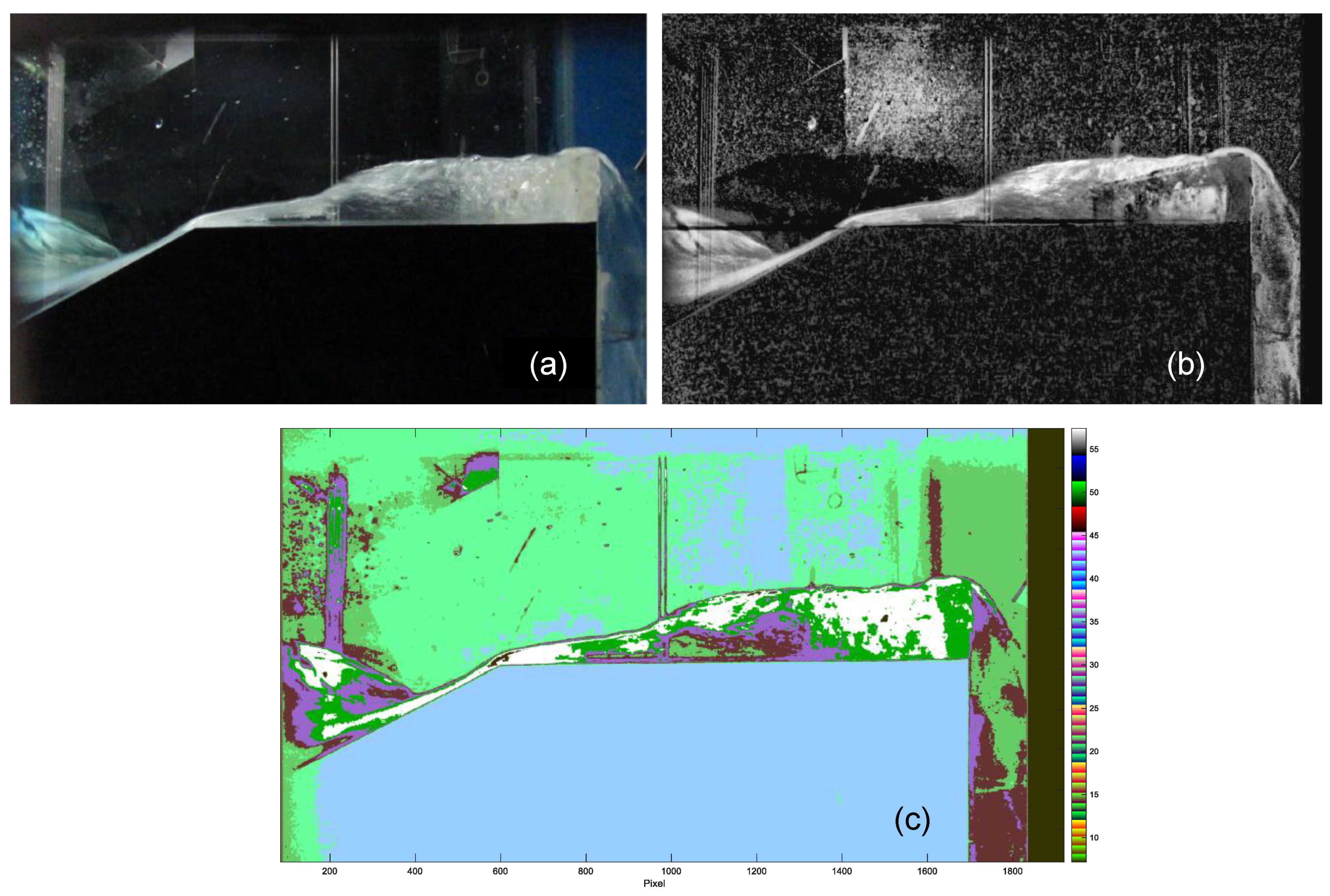

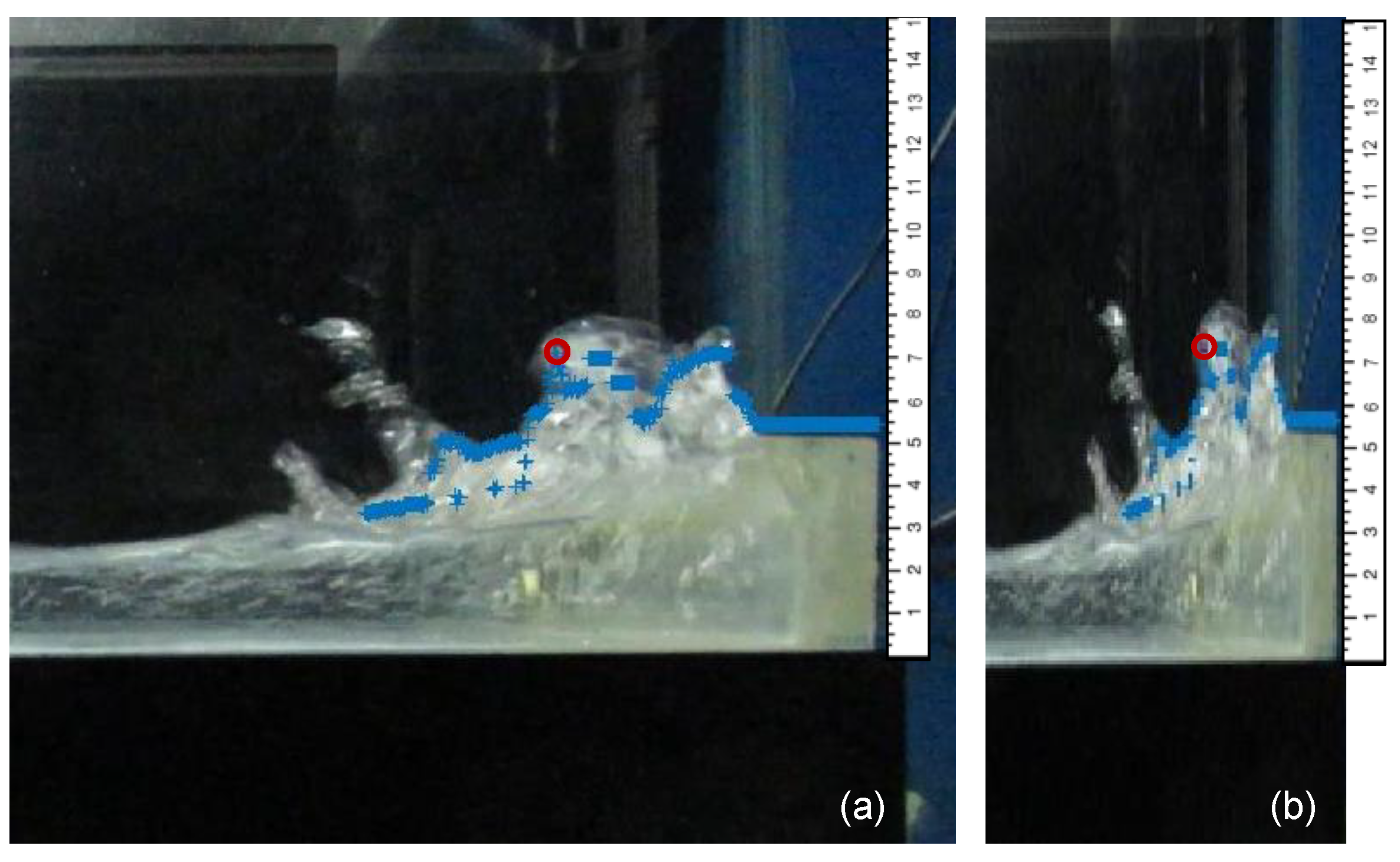

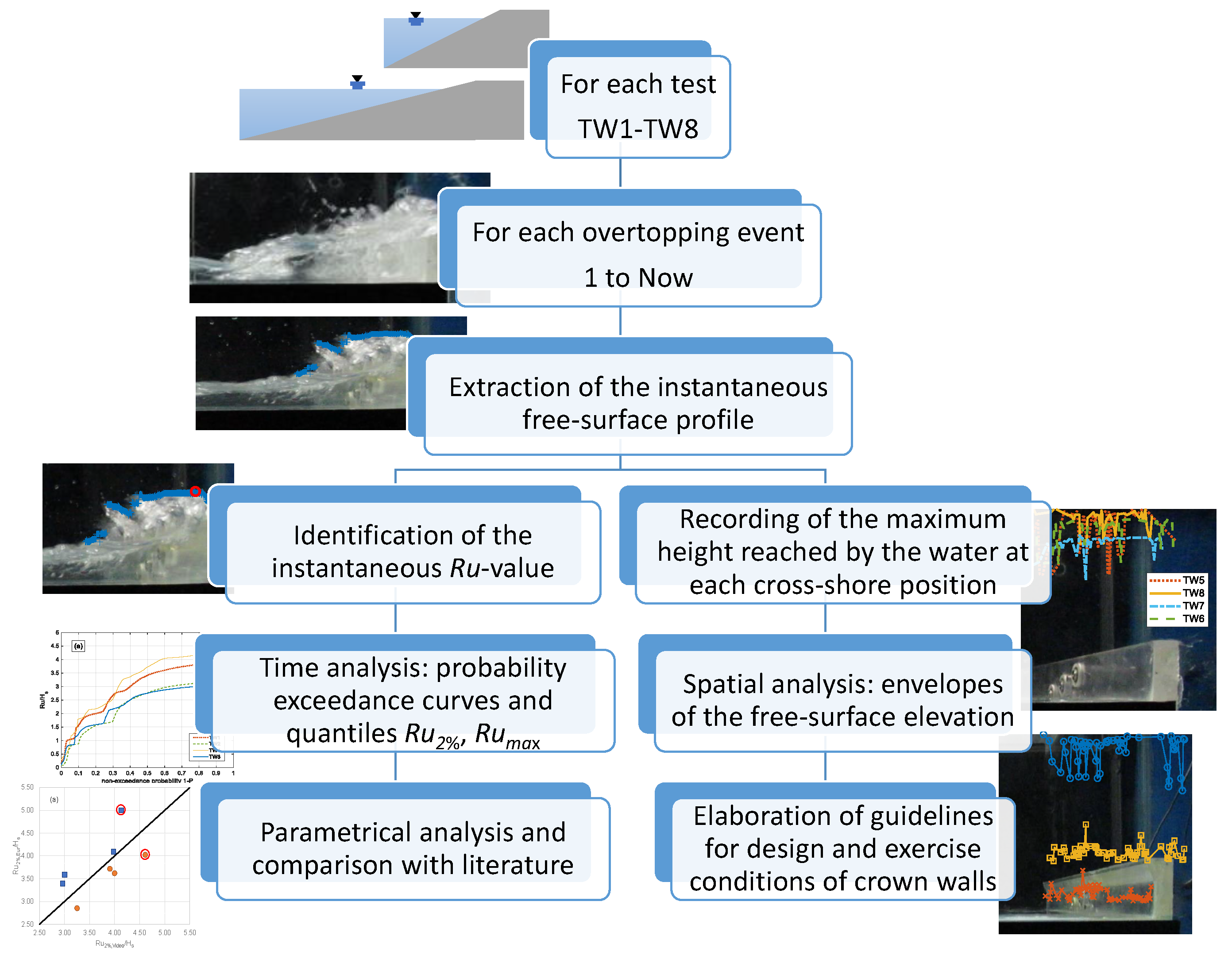
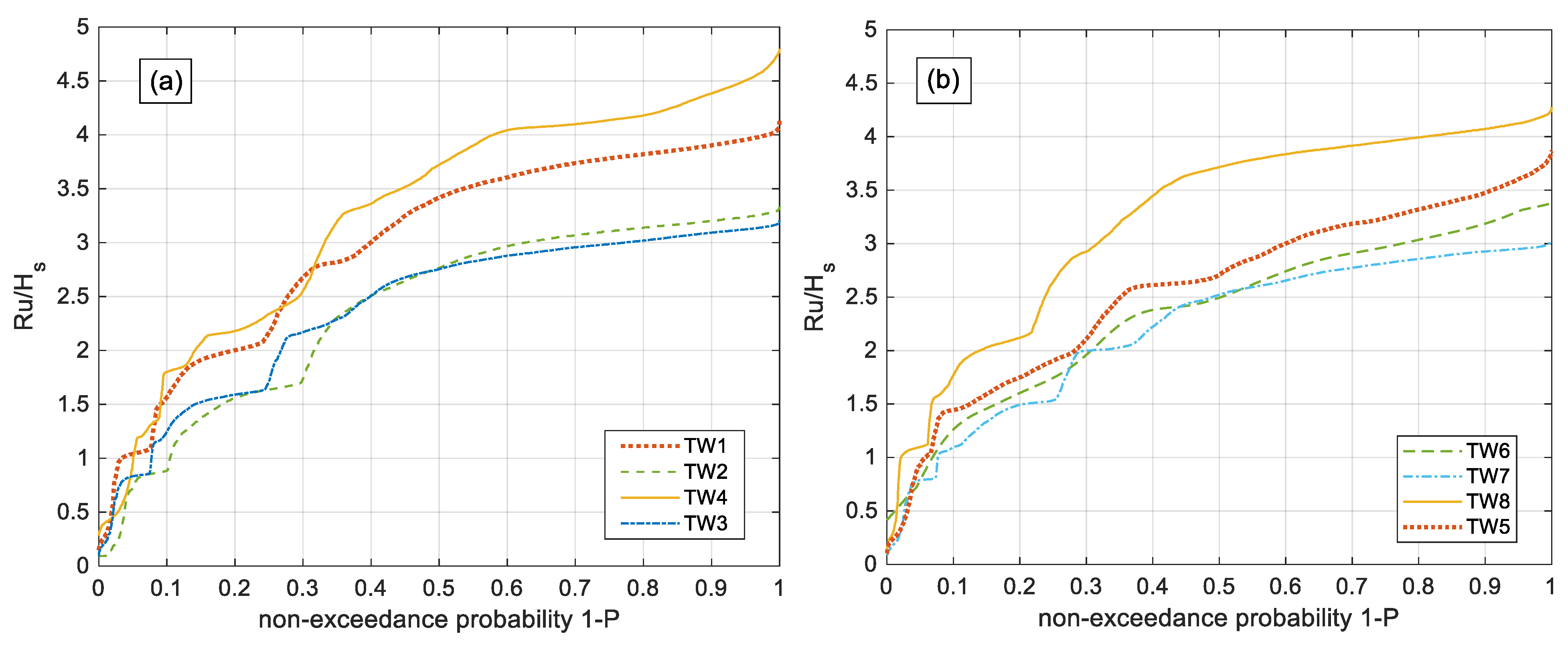
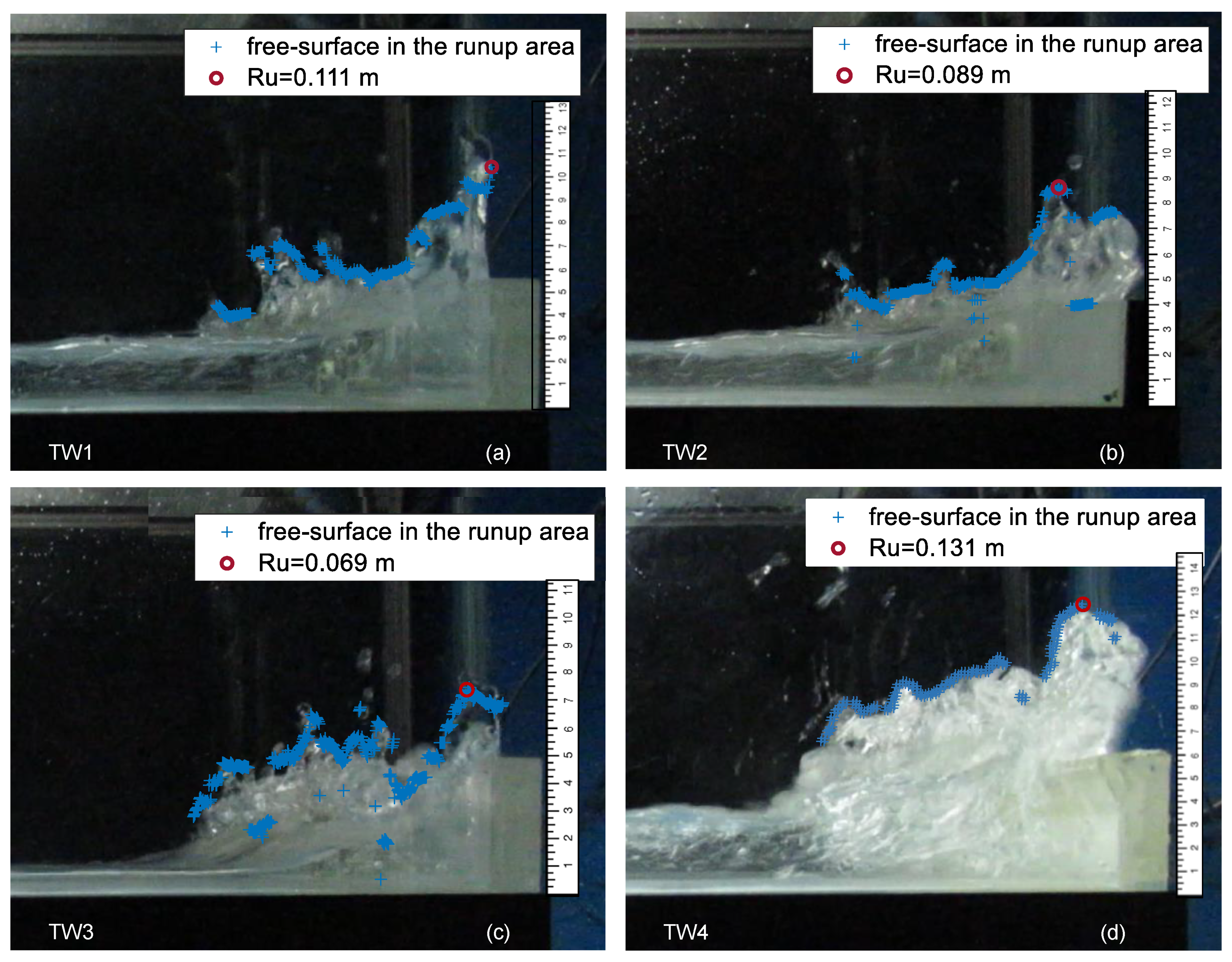
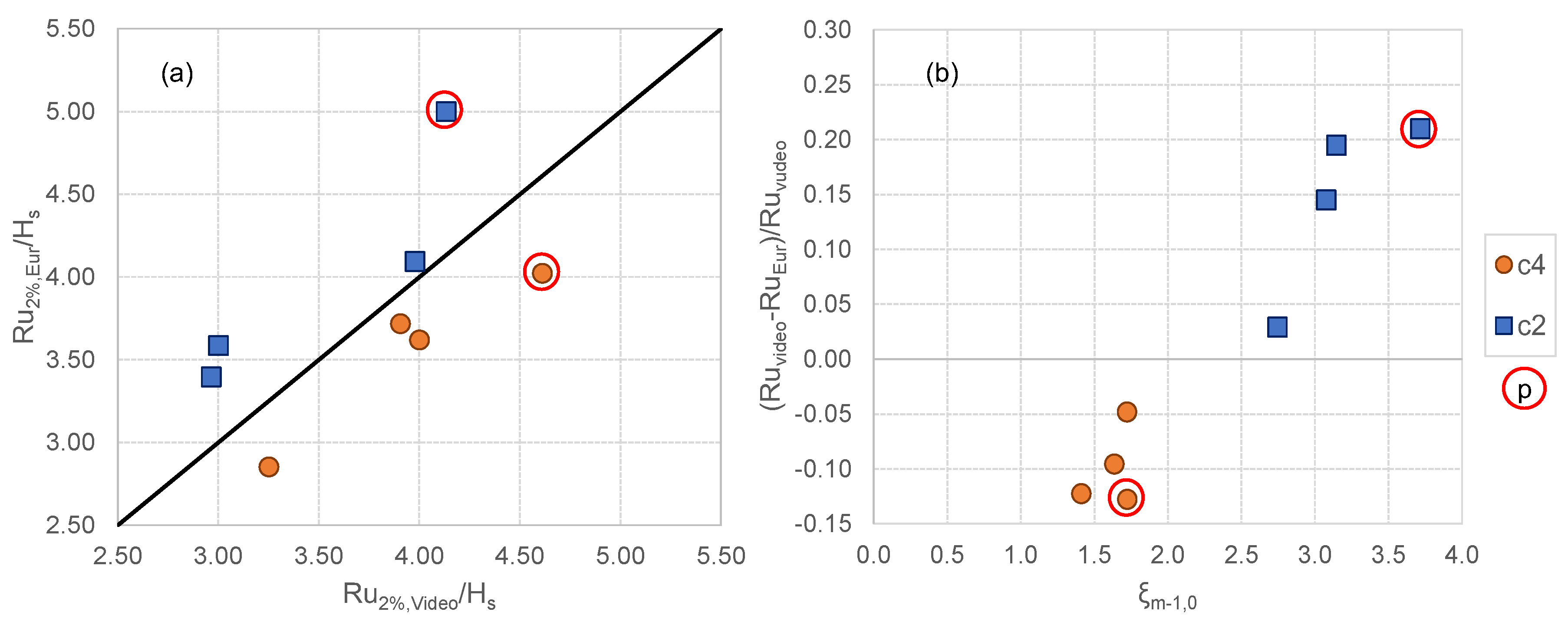
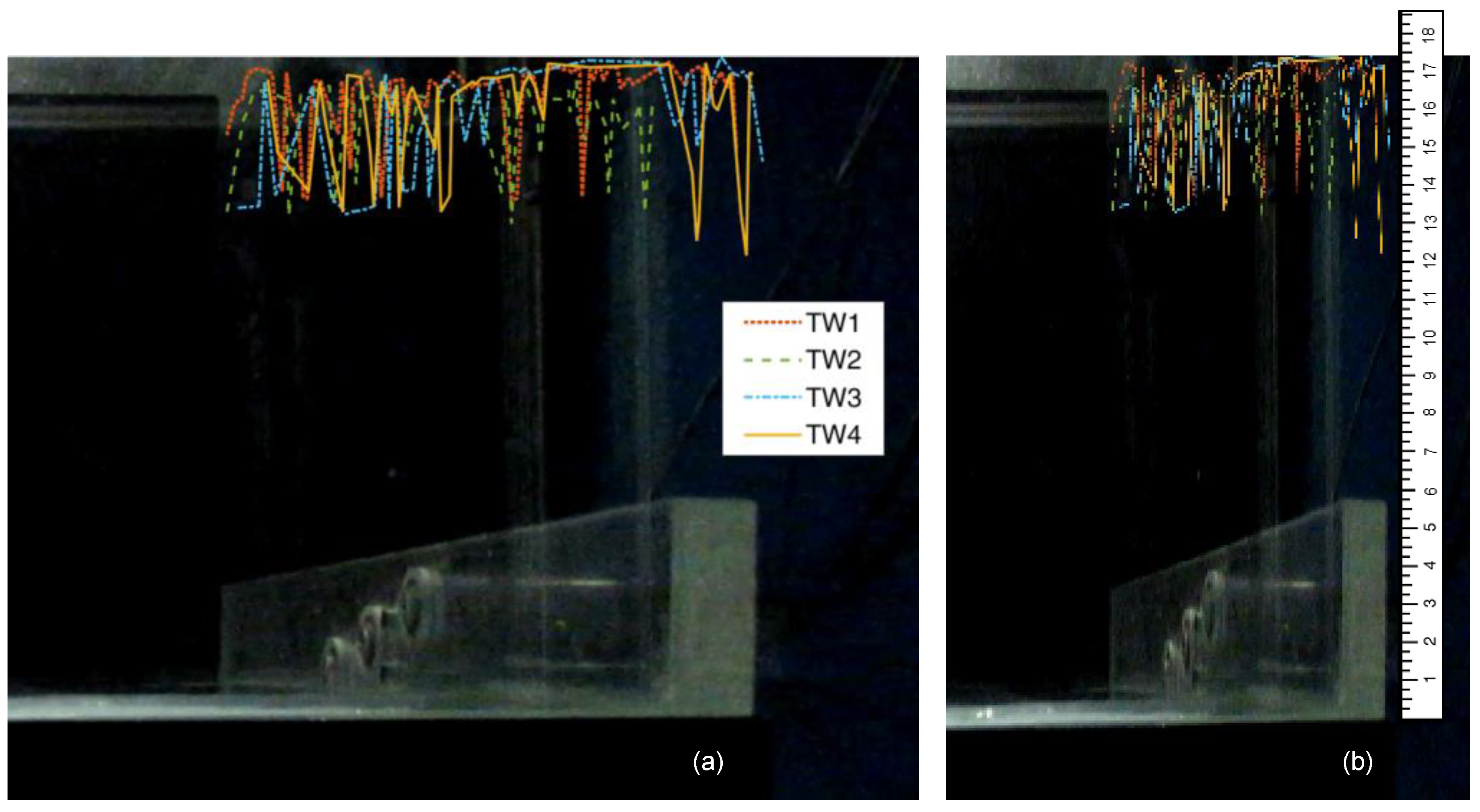


| Test ID | cot(αd) [−] | h [m] | hw [m] | hb/Hs [−] | Parapet |
|---|---|---|---|---|---|
| TW1 | 4 | 0.350 | 0.05 | 0 | - |
| TW2 | 4 | 0.350 | 0.04 | 0 | - |
| TW3 | 4 | 0.325 | 0.05 | 0.5 | - |
| TW4 | 4 | 0.350 | 0.05 | 0 | Yes |
| TW5 | 2 | 0.350 | 0.05 | 0 | - |
| TW6 | 2 | 0.350 | 0.04 | 0 | - |
| TW7 | 2 | 0.325 | 0.05 | 0.5 | - |
| TW8 | 2 | 0.350 | 0.05 | 0 | yes |
| Test ID | MRPE [Pixels] | Rel. Error B [−] | Rel. Error cotαd [−] |
|---|---|---|---|
| TW1 | 2.21 | 0.08 | 0.025 |
| TW2 | 3.05 | 0.09 | 0.01 |
| TW3 | 2.21 | 0.04 | 0.06 |
| TW4 | 1.92 | 0.08 | 0.03 |
| TW5 | 1.11 | 0.06 | 0.04 |
| TW6 | 5.09 | 0.06 | 0.02 |
| TW7 | 1.11 | 0.04 | 0.04 |
| TW8 | 2.73 | 0.05 | 0.04 |
Disclaimer/Publisher’s Note: The statements, opinions and data contained in all publications are solely those of the individual author(s) and contributor(s) and not of MDPI and/or the editor(s). MDPI and/or the editor(s) disclaim responsibility for any injury to people or property resulting from any ideas, methods, instructions or products referred to in the content. |
© 2023 by the authors. Licensee MDPI, Basel, Switzerland. This article is an open access article distributed under the terms and conditions of the Creative Commons Attribution (CC BY) license (https://creativecommons.org/licenses/by/4.0/).
Share and Cite
Formentin, S.M.; Zanuttigh, B. Statistical Analysis of the Wave Runup at Walls in a Changing Climate by Means of Image Clustering. Water 2023, 15, 2729. https://doi.org/10.3390/w15152729
Formentin SM, Zanuttigh B. Statistical Analysis of the Wave Runup at Walls in a Changing Climate by Means of Image Clustering. Water. 2023; 15(15):2729. https://doi.org/10.3390/w15152729
Chicago/Turabian StyleFormentin, Sara Mizar, and Barbara Zanuttigh. 2023. "Statistical Analysis of the Wave Runup at Walls in a Changing Climate by Means of Image Clustering" Water 15, no. 15: 2729. https://doi.org/10.3390/w15152729
APA StyleFormentin, S. M., & Zanuttigh, B. (2023). Statistical Analysis of the Wave Runup at Walls in a Changing Climate by Means of Image Clustering. Water, 15(15), 2729. https://doi.org/10.3390/w15152729







